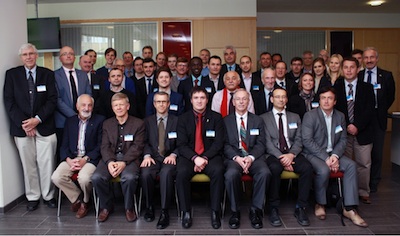AVT-215 Workshop on Innovative Control Effectors for Military Vehicles
The NATO STO/AVT Workshop on “Innovative Control Effectors for Military Vehicles" was held following the Spring AVT Panel Business Meeting Week, in Stockholm, Sweden from 20th to the 22nd of May 2013.
 The AVT-215 workshop provided an opportunity for technical subject matter experts from NATO Nations, Australia and Sweden to exchange experiences and lessons learned in the development and application of Innovative Control Effector Technologies. A Control Effector is any kind of device that could be implemented in an aircraft to control the vehicle by creating forces and moments. New control effector strategies are a requirement for the survivability of future manned and unmanned military vehicles. The survivability of modern aircraft is defined by low visibility and high maneuverability as major drivers. Approaches that do not involve ‘seams’, ‘gaps’ or moving surfaces have been studied in the past and continue to evolve towards ever improving efficiency and ease of integration. There are many approaches that involve seamless geometry movement including morphing leading and trailing edges, morphable wings and wing tips, continuous mould-line technology, etc. These kinds of control effectors are getting more and more important for new military configurations to increase the maneuverability without having a negative effect on the visibility. It is essential in the short term to understand the potential application, applicability and technical feasibility of these technologies and identifying the most suitable candidates for development to a level where they can be exploited on future military platform.
The AVT-215 workshop provided an opportunity for technical subject matter experts from NATO Nations, Australia and Sweden to exchange experiences and lessons learned in the development and application of Innovative Control Effector Technologies. A Control Effector is any kind of device that could be implemented in an aircraft to control the vehicle by creating forces and moments. New control effector strategies are a requirement for the survivability of future manned and unmanned military vehicles. The survivability of modern aircraft is defined by low visibility and high maneuverability as major drivers. Approaches that do not involve ‘seams’, ‘gaps’ or moving surfaces have been studied in the past and continue to evolve towards ever improving efficiency and ease of integration. There are many approaches that involve seamless geometry movement including morphing leading and trailing edges, morphable wings and wing tips, continuous mould-line technology, etc. These kinds of control effectors are getting more and more important for new military configurations to increase the maneuverability without having a negative effect on the visibility. It is essential in the short term to understand the potential application, applicability and technical feasibility of these technologies and identifying the most suitable candidates for development to a level where they can be exploited on future military platform.
The workshop participants aimed to make recommendations for further developments in Innovative Control Effector Technologies by undertaking a critical assessment of the state-of-the-art in these technologies against two generic case study vehicles. Throughout the workshop, a key message conveyed was that the wider integration challenges associated with exploiting these technologies should be considered, i.e.; those over and above the aerodynamic challenge of getting the technologies to function
The workshop was split into two distinct sections. The first two days saw a number of technical presentations being delivered on a range of Novel and Innovative Control Effector technologies. These were broadly considered in terms of their proposed application on an aircraft – high lift, manoeuvring and performance improvement. Each of these sessions were introduced with a requirements paper, outlining the likely performance challenges that would have to be addressed by these technologies should they be exploited. The third day was structured to provide to a number of smaller discussion groups, the opportunity to discuss and debate the issues and challenges associated with applying these technologies onto a real aircraft platform. The workshop formally commenced with a keynote presentation introducing some of the motivation and reasoning behind the workshop and setting the scene for the following days. Following this, twenty two papers were presented and all were of a very high technical quality, covering a range of technologies and addressing a number of issues from performance modeling, to mass and volume considerations. The audience consisted of approximately 50 people.
The Technical Evaluator provided feedback to the workshop attendees as the final action on the third day. In this feedback it was acknowledged that a challenging task had been taken on and there had been a good number of very interesting and relevant presentations.
The workshop identified that for both vehicles there are a number of requirements relating to typical missions that could potentially be met through the use and exploitation of Innovative Control Effector Technologies. It was also clear that almost without exception, although the effectiveness of some of these technologies may be reasonably well understood, very few are mature enough for the integration challenges to be clearly identified and evaluated. This set the scene for the group to propose a number of possible follow-on activities that would assess some of the most promising technologies against a detailed range of performance and integration criteria.
The Meeting Proceedings will be available in the near future from the STO Website.
